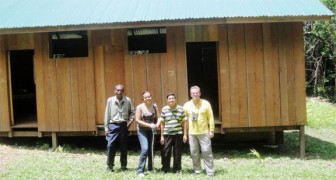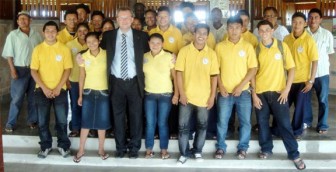Head of the European Union Delegation to Guyana Robert Kopecky commissioned the Toshao’s building at Bina Hill and inspected other EU-funded projects in the Northern Rupununi during a three-day visit to the area last week.
The specific objective of a key project is to strengthen organisational capacity of the North Rupununi District Development Board (NRDDB) which is the umbrella body for 18 communities of the North Rupununi, the EU said in a press release. All of the projects are being implemented by the Iwok-rama International Centre for Rainforest Conservation and Development and are being undertaken in Aranaputa, Wowetta and Rewa to boost Tourism Development and Fisheries.
The project aims to build individual, organisational and institutional capacities in the North Rupununi Wetlands. It started on December 23, 2009 and is expected to be completed next month. The total budget of the project is 300,000 Euros of which the EU has provided 270,000 Euros.

The key areas of focus are to support the NRDDB strategic and business planning to improve long-term sustainability; enhance fisheries management by extending the North Rupununi Arapaima Management Plan to cover all fish species; to enhance awareness and development strategies to manage three key areas in the North Rupununi in Upper Rewa, Pirara-Karanambu-Simuni and the Surama Conservation areas; boost individual capacities in fisheries and resource management and tourism business development; improve existing tourism products in Annai, Aranaputa, Wowetta, Surama, Fairview, Rewa and Yupukari; enhance the international marketing of the Rupununi community tourism products; and build and establish research and tourism networks especially linkages to outside entities.

A manual was developed and management plans were drafted in consultation with the six communities to improve the fisheries sector. The objective is to establish sustainable fishing in the wetlands (rivers and lakes), the release said. Fisheries in the community can be described in three categories: at the community level, small-scale fishing and commercial fishing. Permits are necessary for the latter.

Workshops were held in the communities to create a better framework for fisheries by defining fishing periods for certain species and explaining new fishing techniques and methods. Three of the communities are pursuing aquaculture in their village as fish is the main source of protein. They are interested in rearing Tilapia (a predator), a species that is not indigenous to the area and the project is currently working to promote a local herbivore in the ponds.
In relation to tourism, capacity-building is the main activity. In keeping with this, manuals were developed on financial record keeping, product developing, services delivery, ethics and standards. Workshops were also conducted in the villages and tourism business plans are being finalised. Additionally, a small infrastructure project is currently being undertaken in each village. The release also said the sustainable tourism and fisheries management project is nearing completion and will enhance the capacity of communities in both areas.




